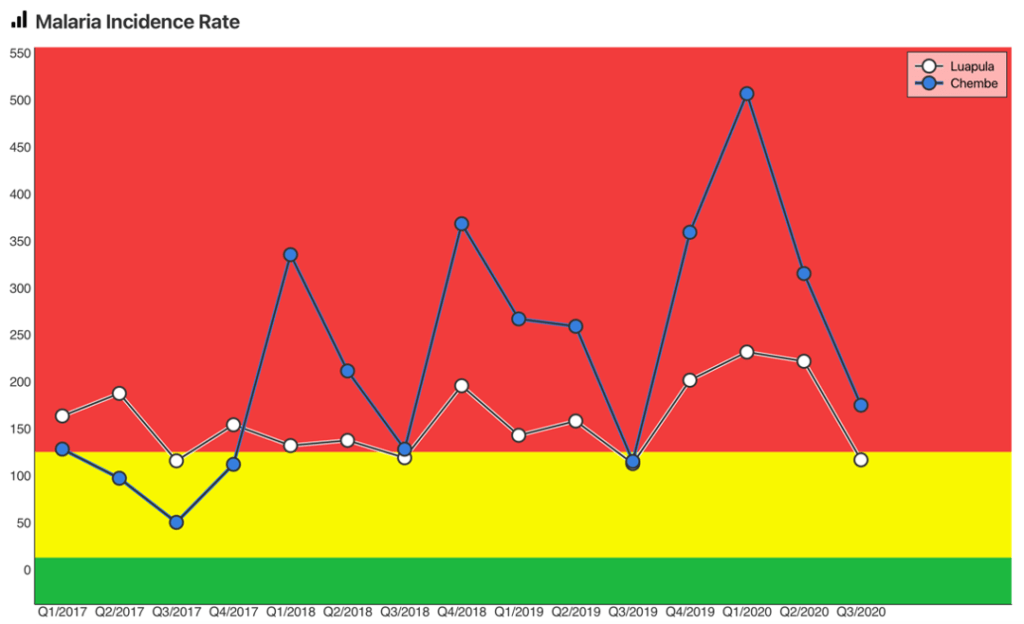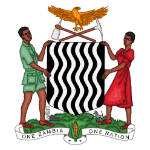Introduction
The malaria burden in Zambia has decreased significantly with the scale-up of control efforts in the past decade, although the disease is still a major public health challenge and remains endemic across all ten provinces. The country’s steady progress in the fight against malaria can be attributed to increased efforts by the Zambian government and partners, as well as the use of innovative tool such as the malaria scorecard management tool.
What is the malaria scorecard management tool?
The scorecard displays performance of priority indicators support action and accountability. The National Malaria Elimination Programme and partners use the scorecard to track progress performance against 11 key malaria indicators nationally and sub-nationally (province, districts) to drive action. Every month, all district health facilities collect and report data on indicators related to case management, vector control and surveillance. This data is collated by the district health information officer (DHIO) and uploaded into Zambia’s Health Management Information system, DHIS2. The National Malaria Elimination Programme (NMEP) M&E officer uses the DHIS2 data to produce the scorecard on a quarterly basis, providing a color-coded snapshot showing the performance of key indicators for discussion at management meetings. Using traffic light colours, the scorecard tool displays performance, with cells showing green when an indicator is on track, yellow when there is progress and red when the indicator is not on track.
In Q1/2019 in Luapula the Scorecard Management tool was used in a weekly management meeting attended by partners leading to increased resource allocation and improved partner coordination in Chembe District resulting in only 2 indicators not on track in Q4/2019.
Workplan manager
The workplan manager is a new functionality of the scorecard tool, rolled out in 2019, that allows integration and alignment of all activities from government and partners and enables the joint tracking of implementation of the annual workplan, listing key milestones and action items and progress against them. The workplan manager is populated in Q1 during the annual workplan harmonization meeting. All stakeholders (Government, Provinces, Districts and Partners) use this process to align their workplans which in turn are used to review performance, identify and address bottlenecks and drive action. Stakeholders can login to the scorecard webplatform to see progress and quickly identify delayed deliverables. The workplan is discussed at several meetings including weekly management meetings at the province or district, quarterly meetings at the district or province, monthly directorate meetings at the NMEP and quarterly meetings of the End Malaria Council.
How the workplan tool helped Luapula improve partner coordination and alignment of malaria activities
The end term review of the 2011-2015 through 2016 Malaria Strategic Plan recorded an implementation and achievement rate of 36%. In order to achieve the objective of eliminating malaria by 2021, the country set as a key objective of the 2017-2021 strategic plan to ‘Increase the implementation rate of interventions from 36% in 2015 to 95 percent by 2018’. The NMEP identified as a key strategy the development of an electronic management tool that would facilitate the processes of translating the strategic plan into operational plans aligned at all levels and across all partner projects, as well as to make transparent in real time tracking of progress. In collaboration with ALMA, the Scorecard web platform has added a feature called the “workplan manager“ function. The workplan manger provides NMEP and End Malaria Council a management tool that tracks national and subnational performance to strengthen accountability and drive action, enable decision-makers to have access to real time data, create a platform with key stakeholders and partners to enable cooperation. Since it was first rolled out, the workplan manager has improved partner coordination and alignment at the national level, as well as in provinces.
In July 2018, the United States Government President’s Malaria Initiative funded Program for the Advancement of Malaria Outcomes (PMI/PAMO) decided to implement enhanced integrated community case management (ICCM) at full scale by training 276 Community Health Workers (CHW). After a successful pilot in Nchelenge District, PMI/PAMO was looking to add another district. In order to select the next district, the province turned to the scorecard management tool which revealed a high incidence rate (see table below) in Chembe District and advised PMI/PAMO to prioritise it. At the weekly management meeting in Q1 of 2019, PAMO decided to award additional resources in the form of training 75 CHW’s in enhanced ICCM at the value of 90,000 USD in Chembe District by 2020, as the malaria incidence rate was the highest in province. The workplan manager extract below shows that CHW training has been scheduled in 2020.

The workplan manager led to improved partner coordination and joint reporting. Together with other partners, GSHC-PSM included its activities to the national and sub-national workplan and hence synchronized planned activities to avoid duplication such as monitoring of the availability of malaria commodities at all levels of the supply chain and to improve transparency.
Mr Noah Mtonga, Global Health Supply Chain – Procurement and Supply Chain management (GHSC-PSM) project funded by the US Government President Malaria Initiative (PMI)
The scorecard management tool leads to improved data quality and service delivery in Luapula Province, Chembe District
In the weekly management meeting in Q1 of 2019, a sudden increase in malaria incidence was observed in one district (Chembe). The province conducted a “triple A” exercise (assessment, analysis and action) to identify and resolve bottlenecks. The scorecard was a key tool used in the assessment process and led to the identification of discrepancies (unexpected figures) in data collected in the Malaria Incidence Rate. The initial conclusion was that there were recording errors at the health facility level and in response as action, a province wide data audit was organised. The finding of the audit was a mismatch between central statistics and actual population on the ground in Chembe district.
The Malaria Incidence Rate in Q1 of 2017 was 128 and in Q1 of 2018 was 335 representing an increase of 262%. The same trend can be seen throughout the 2018 where the incidence rate is in Chembe is higher that the provincial average (not the case in 2017). In Q1 of 2019, at the provincial weekly management meeting, a triple A analysis was done using the scorecard and the results pointed to a community facility that must have been over reporting. The Data Quality Audit conducted revealed that in Chembe, the sudden increase in Malaria Incidence Rate was due to a mismatch between central statistics and actual population on the ground. The culprit was the new sugar cane plantations open between 2017 and 2018 that saw a huge influx in workers outside the district, but the Incidence Rate was calculated on the census statistics from 2010. Indeed, Chembe district has experienced a recent upsurge in population following commencement of a sugar industry. The district official population growth however is based on estimates linked to an almost ten-year-old census. This explains the sudden increase in the number of reported malaria cases per quarter between Q1 of 2018 and Q1 of 2019. This observation has helped the district mobilize additional resources from government and partners.
The analysis of the scorecard has led to improved data. As an example, the observed sudden increase in incidence in one district (Chembe) led to a data audit which showed that a facility was over reporting. This then led to a province wide data audit.
Mateyo Moyo Chief Environmental Officer at Province Health Officer

